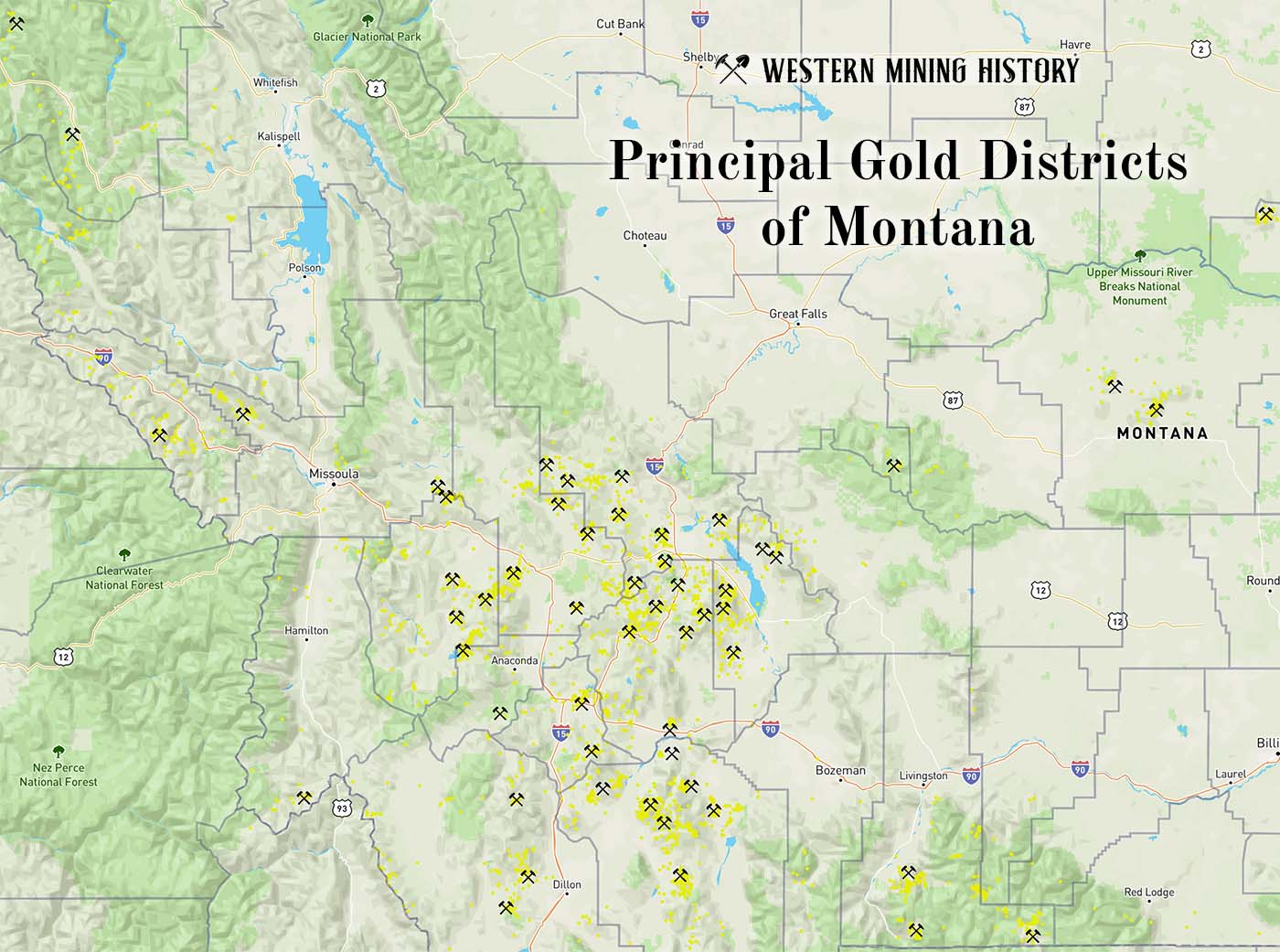The Big Seven Mine is a silver and gold mine located in Cascade county, Montana at an elevation of 7,001 feet.
About the MRDS Data:
All mine locations were obtained from the USGS Mineral Resources Data System. The locations and other information in this database have not been verified for accuracy. It should be assumed that all mines are on private property.
Mine Info
Elevation: 7,001 Feet (2,134 Meters)
Commodity: Silver, Gold
Lat, Long: 46.94917, -110.70472
Map: View on Google Maps
Big Seven Mine MRDS details
Site Name
Primary: Big Seven Mine
Commodity
Primary: Silver
Primary: Gold
Secondary: Copper
Secondary: Lead
Tertiary: Molybdenum
Tertiary: Zinc
Location
State: Montana
County: Cascade
District: Montana (Neihart) District
Land Status
Not available
Holdings
Not available
Workings
Type: Underground
Ownership
Owner Name: Montana Silver Queen Mining Co.
Home Office: Washington, D. C.
Production
Year: 1943
Time Period: 1902-1943
Mined: 131000.000 mt
Material type: ore
Description: Cp_Grade: ^About 0.2 %
Year: 1943
Time Period: 1902 - 1943
Material type: CU
Description: Cp_Grade: ^About 0.02 %
Year: 1943
Time Period: 1902 - 1943
Material type: AU
Description: Cp_Grade: ^About 0.12 Oz/St
Year: 1943
Time Period: 1902 - 1943
Material type: AG
Description: Cp_Grade: ^About 16 Oz/St
Deposit
Record Type: Site
Operation Category: Past Producer
Deposit Type: Polymetallic veins
Operation Type: Unknown
Discovery Year: 1892
Discovery Method: Unknown
Years of Production:
Organization:
Significant: Y
Deposit Size: S
Physiography
General Physiographic Area: Rocky Mountain System
Physiographic Province: Northern Rocky Mountains
Physiographic Detail: Little Belt Mountains
Mineral Deposit Model
Model Name: Polymetallic veins
Orebody
Form: TABULAR
Structure
Type: R
Description: Zone Of Igneous Intrusions Covering Over 800 Square Km.
Type: L
Description: Domal Uplift Caused By Intrusion Of Snow Creek Porphyry, Northeast-Trending Fractures And Faults
Alterations
Alteration Type: L
Alteration Text: Sericitization & Silicification
Rocks
Name: Diorite
Role: Associated
Age Type: Associated Rock
Age Young: Pliocene
Analytical Data
Not available
Materials
Ore: Molybdenite
Ore: Pyrite
Ore: Sphalerite
Ore: Freibergite
Ore: Proustite
Ore: Galena
Ore: Chalcopyrite
Comments
Comment (Reserve-Resource): MOST OF HIGH GRADE ORE BELIEVED MINED OUT - DEVELOPMENT OF LOWER GRADE ORES AT DEPTH POSSIBLE BUT VEIN MAY BE THINNER AT DEPTH.
Comment (Geology): PRECAMBRIAN CRYSTALLINE ROCKS ARE PRE-BELT. SNOW CREEK PORPHYRY ALSO CALLED NEIHART PORPHYRY
Comment (Commodity): SILVER SULFIDES MAINLY IN UPPER WORKINGS - PERCENTAGE OF LEAD & ZINC INCREASED WITH DEPTH HIGH GRADE ORE GENERALLY FOUND AS NARROW STRINGERS WITHIN THE VEIN.
Comment (Location): U.T.M. COORDINATES TAKEN ON PIT LOCATION
Comment (Production): PRODUCTION FIGURES PRIOR TO 1902 UNAVAILABLE BUT RECORDS SHOW EARLY ORES HIGH GRADE SILVER (100 - 500 OZ/ST) WITH GOLD (1 - 3 OZ/ST) SHIPPED. 1902-1943 - 143,274 TONS OF ORE, YIELDING 17,538.86 OZ AU, 2,306,353 OZ AG, 63,022 LBS. CU, 523,369 LBS. PB. OVER $1,000,000 TOTAL PRODUCTION. 1N 1897 - ORE CARRIED 100 TO 500 OPT SILVER, AND $50/TON GOLD. (WEED, 1899)
Comment (Workings): MINE ORIGINALLY DEVELOPED BY 4 ADITS. THE 3 UPPER ADITS FOLLOW THE VEIN SOUTHWARD; THE LOWER, BIG SEVEN, ADIT WAS A CROSSCUT THE FIRST 800 FT. THEN A DRIFT ON THE VEIN THE NEXT 3000 FT. MUCH OF WORKINGS NOW CAVED OR INACCESSIBLE. TWO ORE SHOOTS, EACH ABOUT 600 FT LONG WERE DEVELOPED.
Comment (Exploration): 1890?S ONWARD - OPERATED BY THE BIG SEVEN MINING CO. THEN D.L.S. BARKER. 1935 - MONTANA SILVER QUEEN MINING COMPANY INCORPORATES. 1940-1943 - LEXINGTON MINING COMPANY OPERATED. ENLARGED AND REMODELED 100-TON BULK FLOTATION MILL TO 150-TON SELECTIVE FLOTATION PLANT. REOPENED SOME OF THE ADITS. 1943-1946 - MONTANA LEASING COMPANY OPERATED. 1946 - LEXINGTON SILVER-LEAD MINES, INC. ACQUIRED CONTROL
Comment (Deposit): Discovery Year: EARLY 1890'S
References
Reference (Geology): WEED, W.H., 1900, THE GEOLOGY OF THE LITTLE BELT MOOUNTAINS, MONTANA: U.S. GEOLOGICAL SURVEY TWENTIETH ANNUAL REPORT, PART 3, P. 437-439.
Reference (Deposit): ROBERTSON, A. F., 1951, MINES & MINERAL DEPOSITS - CASCADE COUNTY, MONTANA, U.S. BUREAU MINES INF. CIRC. 7589.
Reference (Deposit): SCHAFER, P. A., 1935, GEOLOGY AND ORE DEPOSITS - NEIHART MINING DISTRICT, CASCADE CO., MONTANA, MT BUREAU OF MINES & GEOLOGY MEM. 13
Reference (Deposit): KLEINKOPF, M. D., WITKIND, I. J., AND KEEFER, W. R., 1972, AEROMAGNETIC, BOUGUER GRAVITY, AND GENERLIZED GEOLOGIC MAPS OF THE CENTRAL PART OF THE LITTLE BELT MOUNTAINS, MONTANA: U.S. GEOLOGICAL SURVEY MAP GP-837
Reference (Production): ROBERTSON, 1951, U.S.B.M. INF. CIRC. 7589
Principal Gold Districts of Montana

In Montana, 54 mining districts have each have produced more than 10,000 ounces of gold. The largest producers are Butte, Helena, Marysville, and Virginia City, each having produced more than one million ounces. Twenty seven other districts are each credited with between 100,000 and one million ounces of gold production. Read more: Principal Gold Districts of Montana.